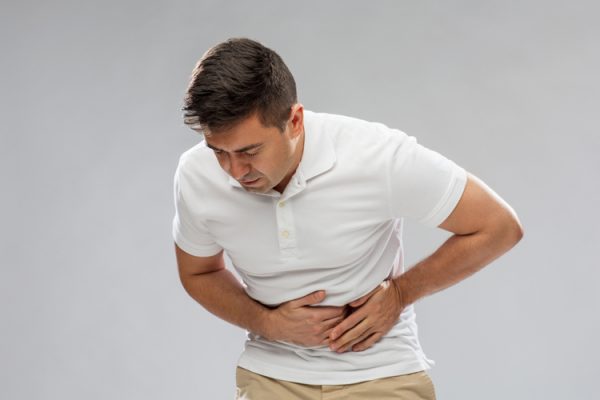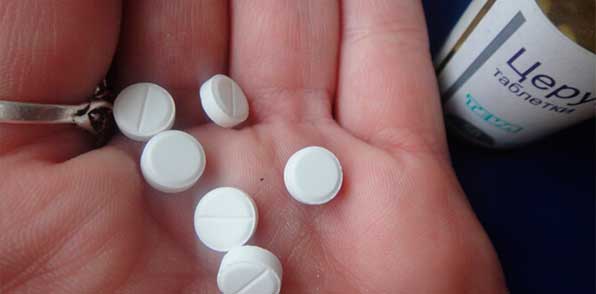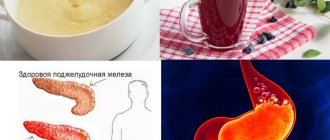Nausea with pancreatitis is quite common, therefore, regular vomiting that occurs during the day, mainly after eating, can be considered as one of the symptoms indicating problems with the pancreas.
If you undergo examination and begin treatment, the nausea will go away. But recovery will take several weeks, so it will be useful to know what to do and what safe remedies can relieve nausea .
Why does one feel sick when the pancreas is inflamed?
Pancreatitis is inflammation of the pancreas. During inflammatory processes, the organ cannot function normally, its work malfunctions - the enzymes that the gland produces do not enter the duodenum, but are activated inside the pancreas itself. As a result, tissue destruction occurs.
The process is accompanied by unpleasant symptoms: mainly pain in the left side of the abdomen, nausea and vomiting radiating to the back. Why do you feel sick with pancreatitis?
Increased production of digestive enzymes, which cannot perform their function , leads to substances entering the circulatory system. The process of intoxication of the body begins.
Important! It is aggravated by the fact that there is a large amount of food in the stomach that is not digested. It is not surprising that nausea in chronic pancreatitis occurs mainly after overeating, consuming fatty heavy foods or alcohol.
An important diagnostic sign that allows the doctor to suspect a problem in the pancreas: vomiting does not bring relief to the patient. If during ordinary poisoning a person feels better after an attack of vomiting, then when vomiting due to pancreatitis, this does not happen. In this case, attacks of vomiting can be repeated repeatedly. Bile impurities can be found in the vomit.

Signs of acute pancreatitis
The first and one of the most important signs of pancreatitis is pain. The appearance of pain is associated with the aggressive effect of digestive enzymes on pancreatic tissue. When necrosis of a significant part of the pancreas occurs (pancreatic necrosis), the pain becomes simply unbearable for a person. Pain with pancreatitis, as a rule, does not decrease, but only intensifies, does not depend on the position of the body, and cannot be corrected with medication. Pain with pancreatitis is predominantly localized in the upper abdomen, has a girdling character (like a hoop), and can radiate (radiate) to the heart area and back.

Nausea is the initial sign of pancreatitis. Nausea usually appears immediately after a heavy intake of junk food or alcohol. Unpleasant sensations in the chest and epigastrium precede vomiting. Vomiting with pancreatitis is repeated (several times), profusely - first with food, then with bile. Nausea and vomiting with pancreatitis are the result of general intoxication and the direct irritating effect of pancreatic enzymes in the digestive tract.
A person who develops acute pancreatitis feels very unwell. In addition to nausea, vomiting and abdominal pain, he is worried about the feeling of interruptions in the functioning of the heart, and there may be diarrhea, which will be replaced by constipation. The man is very pale, his tongue is covered with a white coating, and the oral mucosa is dry.
How to get rid of nausea with pancreatitis and cholecystitis?
Since nausea is caused by increased enzyme activity, it is necessary to stop their production. Therefore, in order to get rid of nausea, you need to stop eating. It is recommended not to even drink water for the first few hours. In the future, if vomiting has already begun, fluid intake will be necessary. This is necessary to eliminate dehydration of the body. You can drink clean water or rosehip decoction.
Attention! The patient should take a lying position and slightly pull his knees towards his chest. During attacks of pancreatitis, this pose helps relieve the condition. It is best to choose a well-ventilated room for rest. You can also apply a cold object to the left side of your abdomen, such as a towel soaked in cool water. This will reduce the activity of the pancreas.

Antiemetic drugs are good for relieving discomfort. They have a strong effect, so the specific drug and its dosage must be determined by a doctor. The same applies to medications that regulate the production of digestive enzymes.
Pancreatitis is often combined with diseases of other gastrointestinal organs, for example, cholecystitis - inflammation of the gallbladder. How to get rid of nausea with pancreatitis and cholecystitis? If the problem of deterioration of the condition lies in the gallbladder, taking antispasmodic drugs is indicated. They will relieve spasm of the biliary tract. You can drink some still mineral water and apply cold water to the right hypochondrium.
After relief of nausea and vomiting, it is necessary to strictly adhere to the diet, because it is poor nutrition that provokes attacks of pancreatitis and cholecystitis. In addition to knowing how to get rid of nausea during pancreatitis, you need to know how to prevent it from happening again.

Important! It is necessary to exclude fatty fried foods, sausages, marinades, fatty meats, and confectionery products from the daily menu. The most preferred cooking method is boiling, steaming, stewing. You need to eat 4-5 times a day, in small portions.
Dosage regimen

The dosage depends on the age and severity of the disease:
| Patient age | Pills | Injection |
| Over 14 years old | One pill, three to four approaches per day. | Oda ampoule, 1-3 injections per day. |
| Under 14 years old | Half a pill or one tablet, two to three approaches per day. | Depends on the patient's weight. To calculate the concentration of the solution, a ratio of 0.1-0.5 mg is used. drug for every kilogram of body weight. |
According to the general instructions, the pills are taken half an hour before meals, with approximately 150 ml. clean water. The next tablet can be taken after 5-6 hours. In one approach, you can take no more than two pills (20 mg), and you can use no more than six tablets (60 mg) per day.
The presence of certain pathological conditions may affect the dosage calculation:
- Liver damage in combination with ascites - the amount of medicine is divided into two parts.
- Diabetic gastroparesis - it is advisable to switch to a combined medication regimen: after breakfast, administer an intramuscular injection, and take the tablet form during the day.
- For kidney disease, the dosage depends on the creatinine clearance rate: below 10 ml/min – no more than 1 tablet/ampule of Cerucal per day; within 11-60 ml/min – in the morning 1 tablet/ampoule, in the evening ½ morning dose; over 60 ml/min, the medication is taken according to the classical regimen.
The duration of treatment is determined by the doctor. On average, it can last from four to six weeks. If there are serious indications, the doctor may extend the course to six months.
Which form of medication should I choose – tablets or injections?
If the adult patient is feeling stable and there is no excessive vomiting, doctors recommend taking the tablet form of the medicine. This recommendation is due to the fact that the tablets have a prolonged therapeutic effect for almost 6 hours, while the injections stop working after 2 hours.
Injections act as an “ambulance” when it is necessary to instantly bring a person to his senses and alleviate his condition. They are also used against the background of vomiting, attacks of hiccups or nausea, if the patient is unable to swallow the tablet and not vomit for 20 minutes. In exceptional situations, prolonged use of injections is allowed for up to 14-28 days.
Children 2-14 years old are often prescribed an injectable form of Cerucal so that the dosage of the substance is calculated as accurately as possible based on the child’s weight.
Interaction with other drugs
Cerucal affects the degree of exposure and concentration of the following medications:
| Reduces efficiency | Increases concentration or efficiency |
| Anticholinesterase. Cimetidine. Digoxin. H12-histamine receptor blockers. Pergolis. | Bromocriptine. Tetracycline. Ampicillin. Levodopa. Paracetamol. Lithium preparations. Medicines that depress the central nervous system. Cyclosporine. |
Cerucal enhances the effects of ethanol and can change the effect of antidepressants and the toxicity of hepatotoxic drugs. Neuroleptics increase the risk of side effects of Cerucal.
Doctors' advice

With prolonged vomiting, the body rapidly loses fluid. This negatively affects the functioning of all its systems and disrupts the electrolyte balance.
If the patient is hospitalized, he will be given an IV to help correct the nutritional deficiency.
How to relieve nausea with pancreatitis at home? When the period of vomiting is over, plain water with the addition of medicinal decoctions - chamomile, yarrow, string, lingonberry - will help get rid of the discomfort.
It is best to have a doctor confirm the safety of using such decoctions. Under no circumstances should you add lemon juice to water, this will increase the acidity in the stomach and worsen the patient’s condition.
Important! If there are traces of blood in the vomit, unbearable pain appears, pale skin, a drop in blood pressure, or confusion occur, you must call an ambulance. It is possible that only emergency surgery can help.
Nausea due to pancreatic disease is a classic symptom that signals that the functioning of the digestive system in the body is impaired . To establish an accurate diagnosis, it is necessary to undergo examinations - a general blood and urine test, and an ultrasound of the pancreas. Timely treatment will help avoid possible serious complications that pose a threat to life - for example, an attack of acute pancreatitis or pancreatic necrosis.
What to do if vomiting develops
If vomiting occurs, medications are used to help replenish lost fluid and restore electrolyte balance:
- infusion therapy to normalize the volume of fluid and electrolytes;
- analgesics;
- anti-vomiting agents.
The latter are used when the attack continues despite treatment. They belong to various pharmacological groups, their use is symptomatic therapy: Domperidone, Domidon, Cerucal, Metoclopramide, Reglan, Osetron, Ciel, etc.
Self-treatment of vomiting fails, because taking drugs in tablet form is ineffective: they do not have time to be absorbed in the stomach. Infusion therapy is required in a hospital setting. It is prescribed depending on the severity of the condition individually in each specific case. Stopping vomiting without further detoxification therapy will cause the accumulation of toxic substances and increased intoxication.
The high mortality rate from pancreatitis and its complications is due to late seeking medical help.
If vomiting occurs, you must contact a specialist for examination, clarification of the diagnosis and prescription of treatment, taking into account the identified causes. Only a doctor can adequately assess the condition and prescribe complete treatment that will lead to success.
Source: gastrolekar.ru










